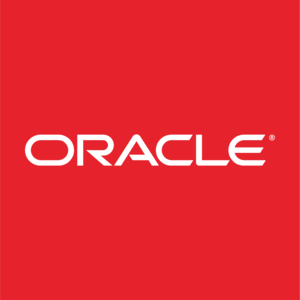
Elastic (ESTC)
We aren’t fans of Elastic. Its revenue growth has decelerated and its historical operating losses don’t give us confidence in a turnaround.― StockStory Analyst Team
1. News
2. Summary
Why Elastic Is Not Exciting
Built on the powerful open-source Elasticsearch technology that powers search functionality for thousands of websites worldwide, Elastic (NYSE:ESTC) provides a search and AI platform that helps organizations find insights from their data, monitor applications, and protect against security threats.
- Operating margin improvement of 5.9 percentage points over the last year demonstrates its ability to scale efficiently
- Track record of operating margin losses stem from its decision to pursue growth instead of profits
- A bright spot is that its software offerings and brand resonate with consumers, as seen in its above-market 25.8% annual sales growth over the last five years


Elastic’s quality doesn’t meet our hurdle. We’ve identified better opportunities elsewhere.
Why There Are Better Opportunities Than Elastic
High Quality
Investable
Underperform
Why There Are Better Opportunities Than Elastic
Elastic’s stock price of $76.63 implies a valuation ratio of 4.5x forward price-to-sales. This is a cheap valuation multiple, but for good reason. You get what you pay for.
We’d rather pay up for companies with elite fundamentals than get a bargain on weak ones. Cheap stocks can be value traps, and as their performance deteriorates, they will stay cheap or get even cheaper.
3. Elastic (ESTC) Research Report: Q3 CY2025 Update
Search AI platform provider Elastic (NYSE:ESTC) reported revenue ahead of Wall Streets expectations in Q3 CY2025, with sales up 15.9% year on year to $423.5 million. Guidance for next quarter’s revenue was optimistic at $438 million at the midpoint, 2% above analysts’ estimates. Its non-GAAP profit of $0.64 per share was 11.1% above analysts’ consensus estimates.
Elastic (ESTC) Q3 CY2025 Highlights:
- Revenue: $423.5 million vs analyst estimates of $417.9 million (15.9% year-on-year growth, 1.3% beat)
- Adjusted EPS: $0.64 vs analyst estimates of $0.58 (11.1% beat)
- Adjusted Operating Income: $69.8 million vs analyst estimates of $67.02 million (16.5% margin, 4.1% beat)
- The company lifted its revenue guidance for the full year to $1.72 billion at the midpoint from $1.68 billion, a 2% increase
- Management raised its full-year Adjusted EPS guidance to $2.43 at the midpoint, a 4.7% increase
- Operating Margin: -1.9%, in line with the same quarter last year
- Free Cash Flow Margin: 6.1%, down from 25.1% in the previous quarter
- Net Revenue Retention Rate: 112%, in line with the previous quarter
- Billings: $399.6 million at quarter end, up 4.3% year on year
- Market Capitalization: $9.38 billion
Company Overview
Built on the powerful open-source Elasticsearch technology that powers search functionality for thousands of websites worldwide, Elastic (NYSE:ESTC) provides a search and AI platform that helps organizations find insights from their data, monitor applications, and protect against security threats.
Elastic's platform is centered around three main solutions: Search, Observability, and Security. The Search solution enables organizations to build AI-powered search applications that can retrieve information across vast datasets, powering everything from website search to customer support portals. The Observability solution helps IT teams monitor and troubleshoot their applications, infrastructure, and networks by collecting and analyzing logs, metrics, and performance data. The Security solution provides threat detection and response capabilities to protect against cyber attacks.
At the core of Elastic's offerings is the Elastic Stack, which includes Elasticsearch (a highly scalable search engine and data store), Kibana (a visualization and management interface), and data collection tools like Elastic Agent and Logstash. The company has enhanced these tools with AI and machine learning capabilities, including support for vector search and large language models, allowing customers to build generative AI applications with their own data.
Customers can deploy Elastic's software in multiple ways: as a fully-managed service called Elastic Cloud hosted on major public cloud providers like AWS, Google Cloud, and Microsoft Azure; or as self-managed software in their own environments. Elastic employs a "freemium" business model, offering basic features for free to build community adoption while charging subscription fees for advanced features and hosted services. This approach has helped the company build a customer base of approximately 21,000 organizations across industries ranging from technology and finance to healthcare and government.
4. Data Infrastructure
Generating insights from system level data is an increasing priority for most businesses, but to do so requires connecting and analyzing piles of data stored and siloed in separate databases. This is the demand driver for cloud based data infrastructure software providers, who can more readily integrate, distribute and process information vs. legacy on-premise software providers.
Elastic competes with various companies across its solution areas, including Splunk (owned by Cisco Systems), Datadog (NASDAQ:DDOG), and Dynatrace (NYSE:DT) in observability; CrowdStrike (NASDAQ:CRWD) and Microsoft's Azure Sentinel (NASDAQ:MSFT) in security; and Algolia, Lucidworks, and Google (NASDAQ:GOOGL) in search applications.
5. Revenue Growth
Reviewing a company’s long-term sales performance reveals insights into its quality. Any business can put up a good quarter or two, but many enduring ones grow for years. Over the last five years, Elastic grew its sales at a solid 25.8% compounded annual growth rate. Its growth beat the average software company and shows its offerings resonate with customers.
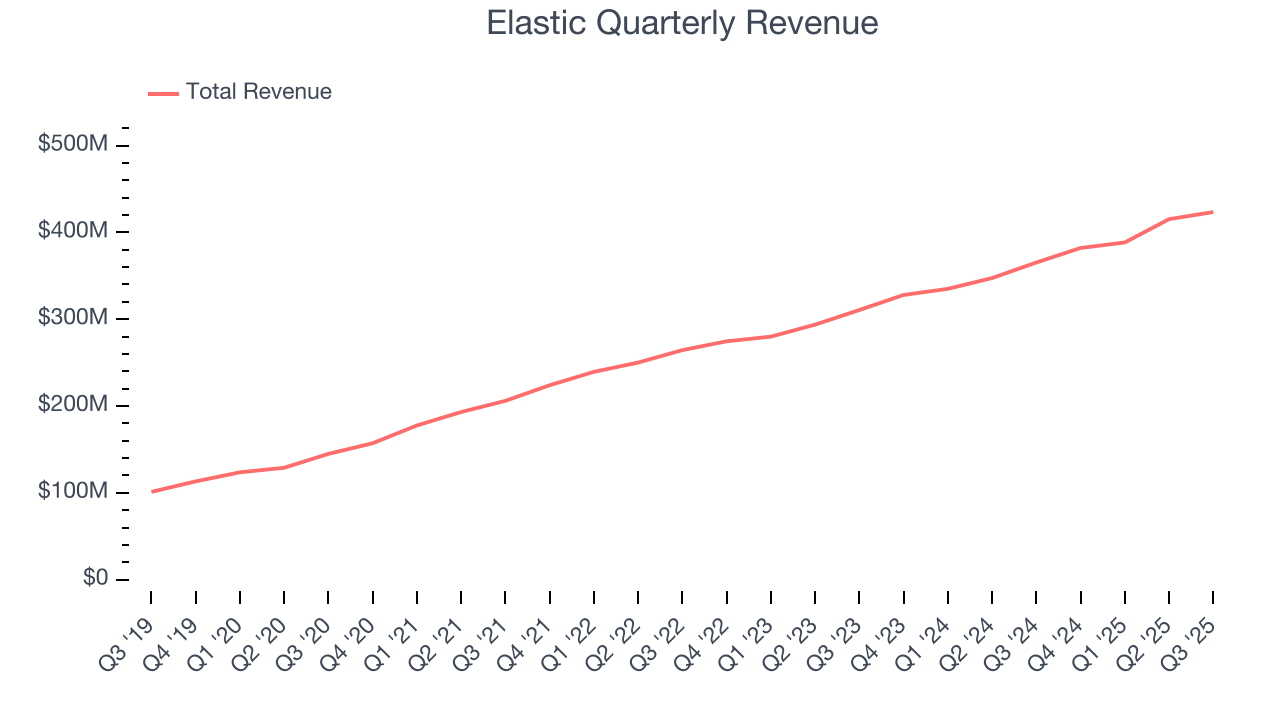
Long-term growth is the most important, but within software, a half-decade historical view may miss new innovations or demand cycles. Elastic’s annualized revenue growth of 17.8% over the last two years is below its five-year trend, but we still think the results suggest healthy demand. 
This quarter, Elastic reported year-on-year revenue growth of 15.9%, and its $423.5 million of revenue exceeded Wall Street’s estimates by 1.3%. Company management is currently guiding for a 14.6% year-on-year increase in sales next quarter.
Looking further ahead, sell-side analysts expect revenue to grow 11.9% over the next 12 months, a deceleration versus the last two years. This projection is underwhelming and implies its products and services will see some demand headwinds.
6. Billings
Billings is a non-GAAP metric that is often called “cash revenue” because it shows how much money the company has collected from customers in a certain period. This is different from revenue, which must be recognized in pieces over the length of a contract.
Elastic’s billings came in at $399.6 million in Q3, and over the last four quarters, its growth slightly lagged the sector as it averaged 13.8% year-on-year increases. This alternate topline metric grew slower than total sales, meaning the company recognizes revenue faster than it collects cash - a headwind for its liquidity that could also signal a slowdown in future revenue growth. 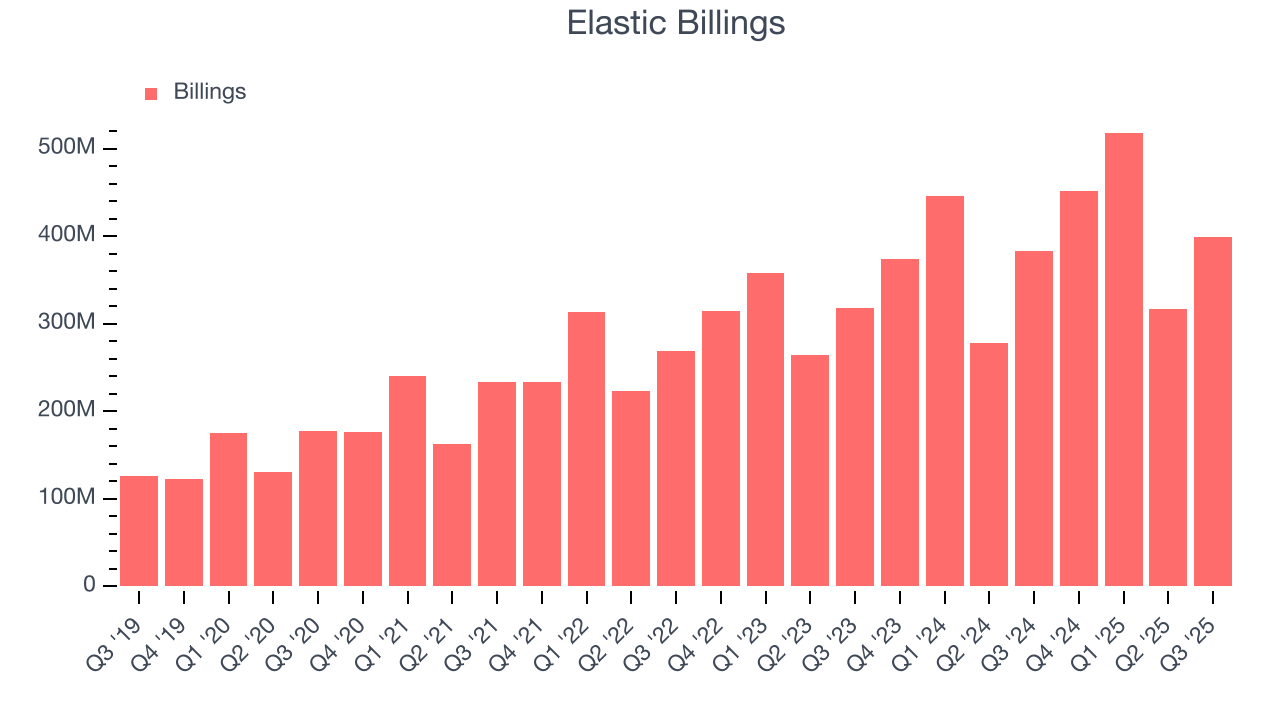
7. Enterprise Customer Base
This quarter, Elastic reported 1,550 enterprise customers paying more than $100,000 annually, flat versus the previous quarter. We’ve no doubt shareholders would like to see the company accelerate its sales momentum.
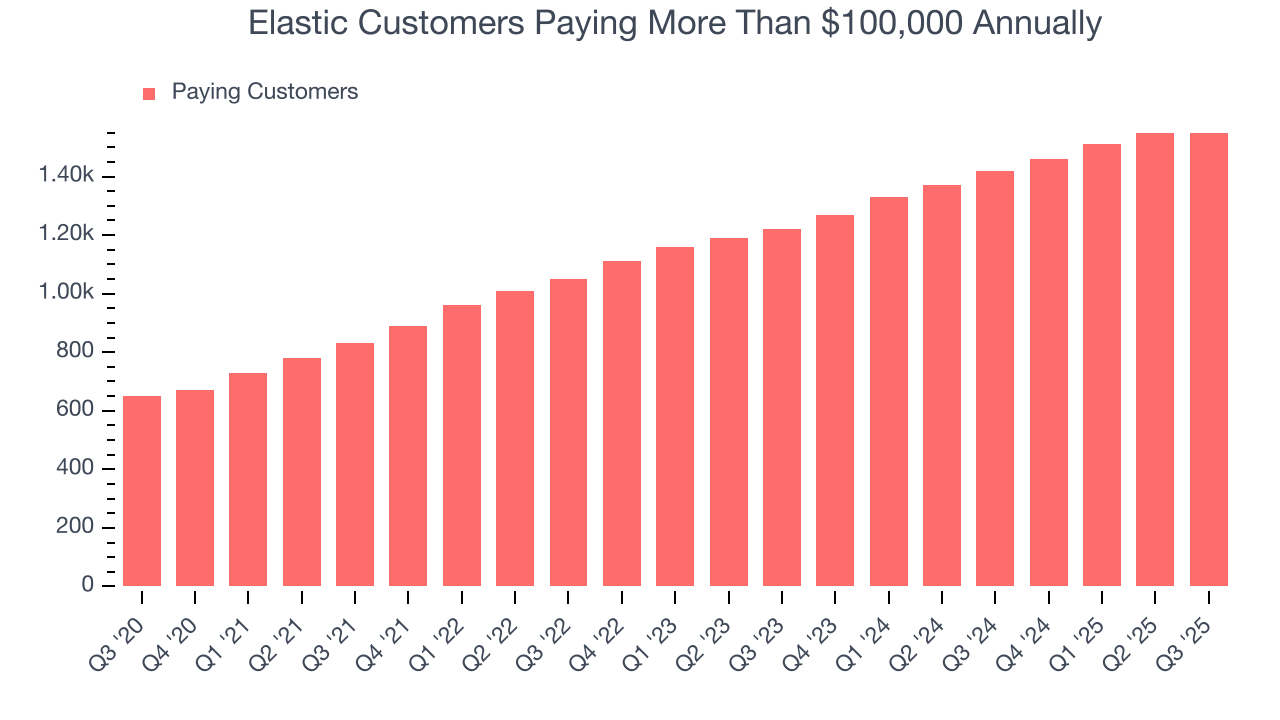
8. Customer Acquisition Efficiency
The customer acquisition cost (CAC) payback period represents the months required to recover the cost of acquiring a new customer. Essentially, it’s the break-even point for sales and marketing investments. A shorter CAC payback period is ideal, as it implies better returns on investment and business scalability.
It’s relatively expensive for Elastic to acquire new customers as its CAC payback period checked in at 59.4 months this quarter. The company’s drawn-out sales cycles partly stem from its focus on enterprise clients who require some degree of customization, resulting in long onboarding periods that delay delay returns and limit customer growth. 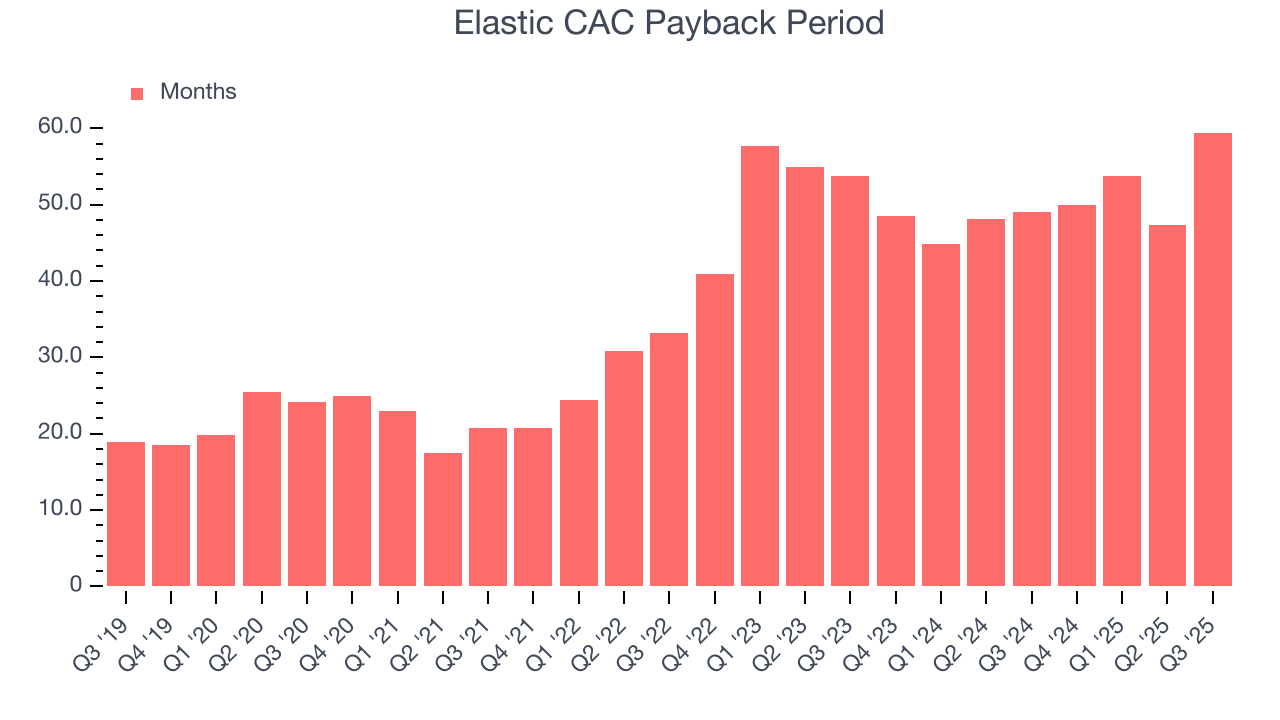
9. Customer Retention
One of the best parts about the software-as-a-service business model (and a reason why they trade at high valuation multiples) is that customers typically spend more on a company’s products and services over time.
Elastic’s net revenue retention rate, a key performance metric measuring how much money existing customers from a year ago are spending today, was 112% in Q3. This means Elastic would’ve grown its revenue by 12% even if it didn’t win any new customers over the last 12 months.
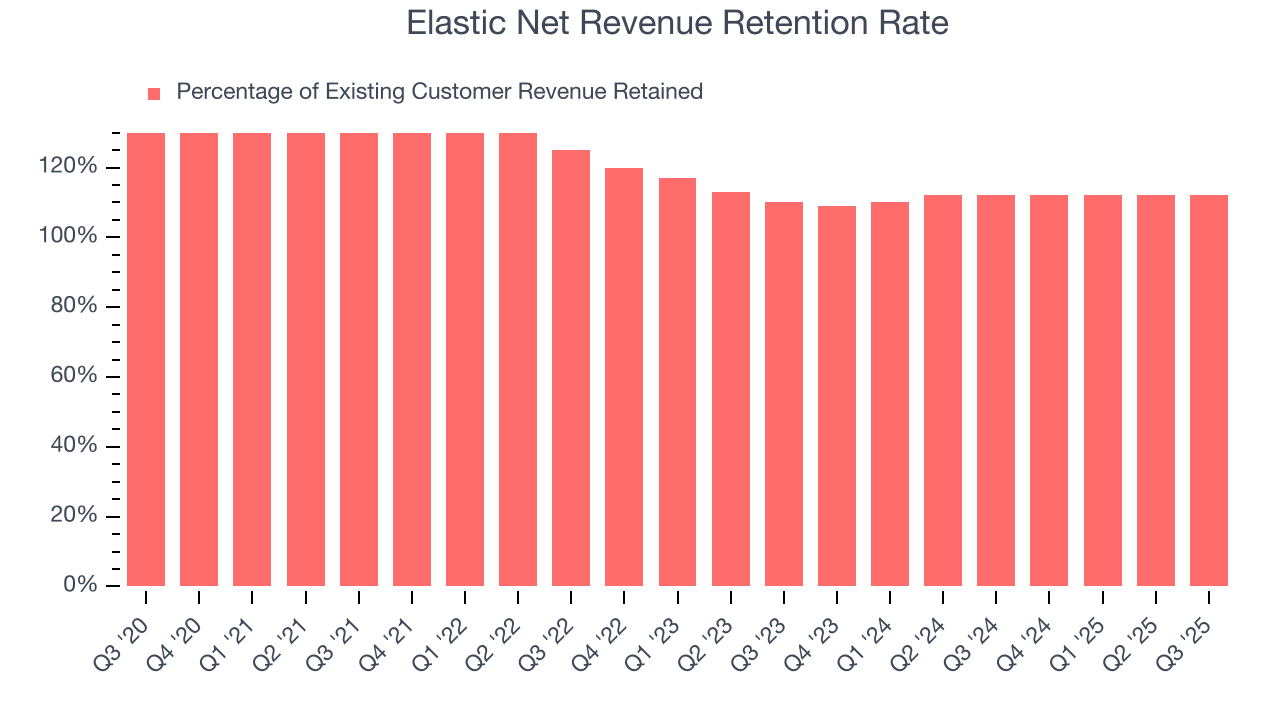
Elastic has a good net retention rate, proving that customers are satisfied with its software and getting more value from it over time, which is always great to see.
10. Gross Margin & Pricing Power
For software companies like Elastic, gross profit tells us how much money remains after paying for the base cost of products and services (typically servers, licenses, and certain personnel). These costs are usually low as a percentage of revenue, explaining why software is more lucrative than other sectors.
Elastic’s gross margin is good for a software business and points to its solid unit economics, competitive products and services, and lack of meaningful pricing pressure. As you can see below, it averaged an impressive 75.6% gross margin over the last year. Said differently, Elastic paid its providers $24.38 for every $100 in revenue.
The market not only cares about gross margin levels but also how they change over time because expansion creates firepower for profitability and free cash generation. Elastic has seen gross margins improve by 1.9 percentage points over the last 2 year, which is solid in the software space.
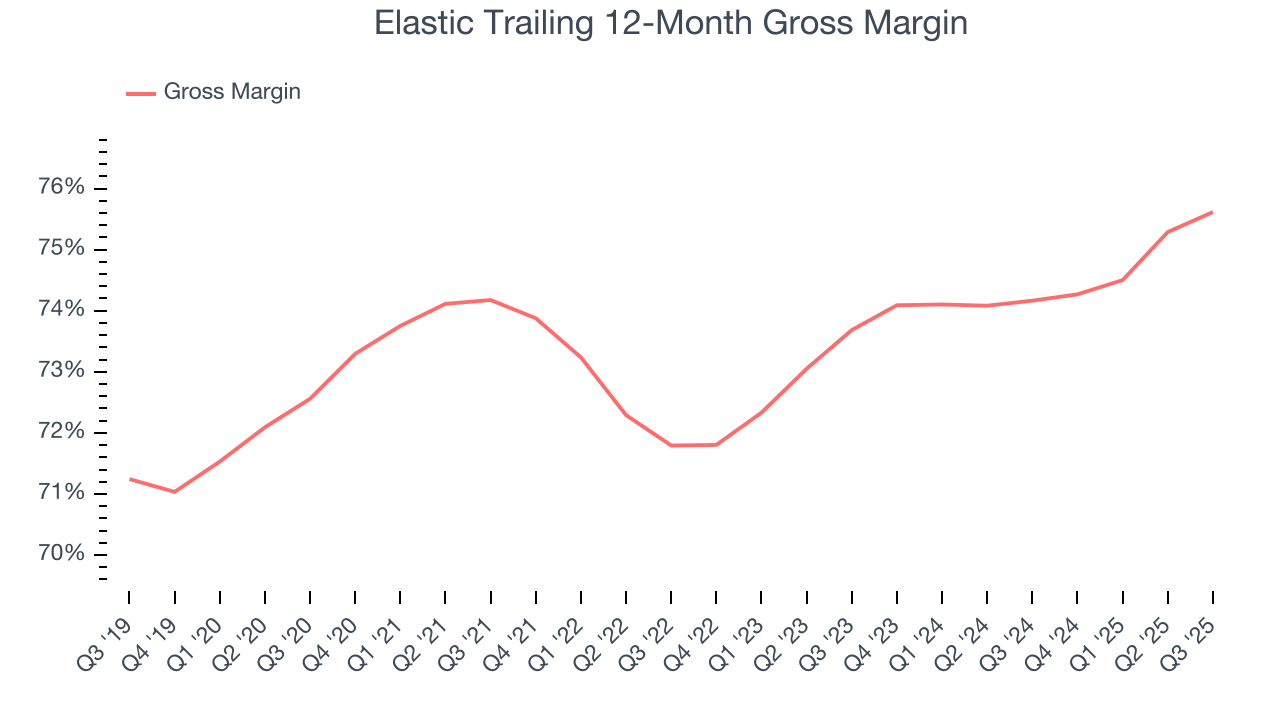
Elastic’s gross profit margin came in at 75.9% this quarter, up 1.3 percentage points year on year. Elastic’s full-year margin has also been trending up over the past 12 months, increasing by 1.5 percentage points. If this move continues, it could suggest better unit economics due to more leverage from its growing sales on the fixed portion of its cost of goods sold (such as servers).
11. Operating Margin
Many software businesses adjust their profits for stock-based compensation (SBC), but we prioritize GAAP operating margin because SBC is a real expense used to attract and retain engineering and sales talent. This is one of the best measures of profitability because it shows how much money a company takes home after developing, marketing, and selling its products.
Elastic’s expensive cost structure has contributed to an average operating margin of negative 2.1% over the last year. Unprofitable, high-growth software companies require extra attention because they spend heaps of money to capture market share. As seen in its fast historical revenue growth, this strategy seems to have worked so far, but it’s unclear what would happen if Elastic reeled back its investments. Wall Street seems to think it will face some obstacles, and we tend to agree.
Over the last two years, Elastic’s expanding sales gave it operating leverage as its margin rose by 5.9 percentage points. Still, it will take much more for the company to reach long-term profitability.
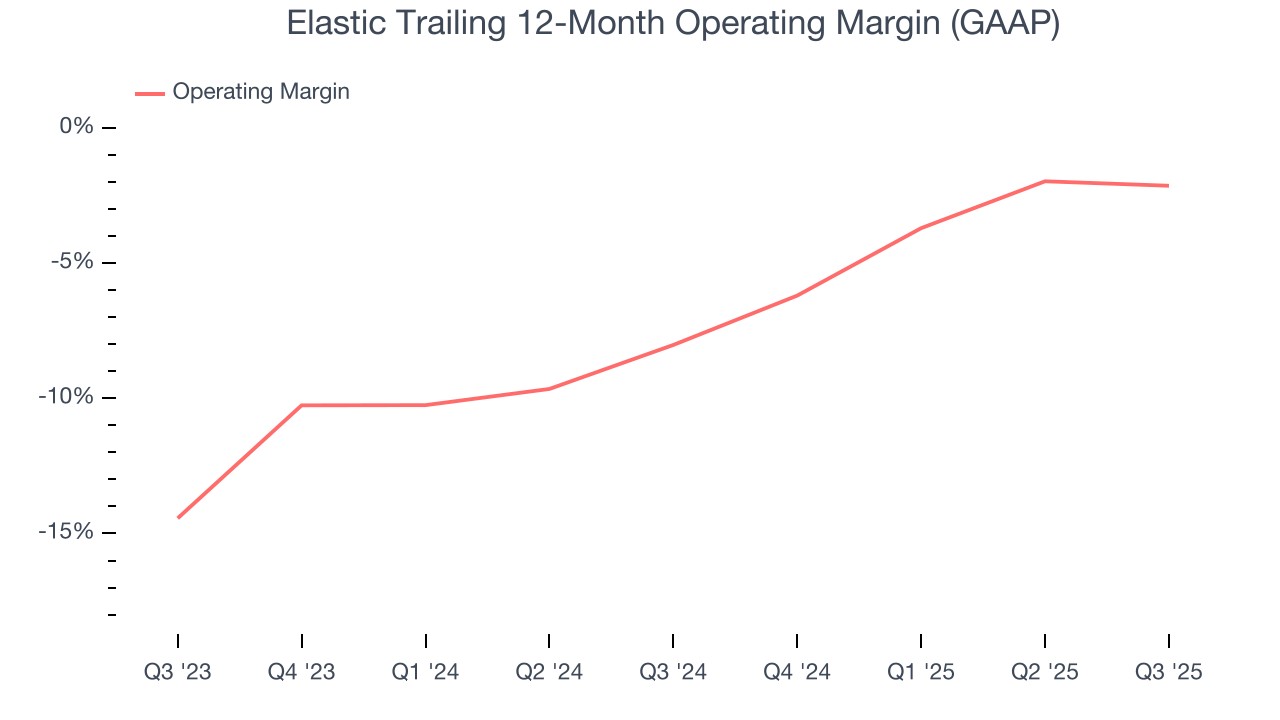
In Q3, Elastic generated a negative 1.9% operating margin.
12. Cash Is King
Although earnings are undoubtedly valuable for assessing company performance, we believe cash is king because you can’t use accounting profits to pay the bills.
Elastic has shown decent cash profitability, giving it some flexibility to reinvest or return capital to investors. The company’s free cash flow margin averaged 18.8% over the last year, slightly better than the broader software sector.
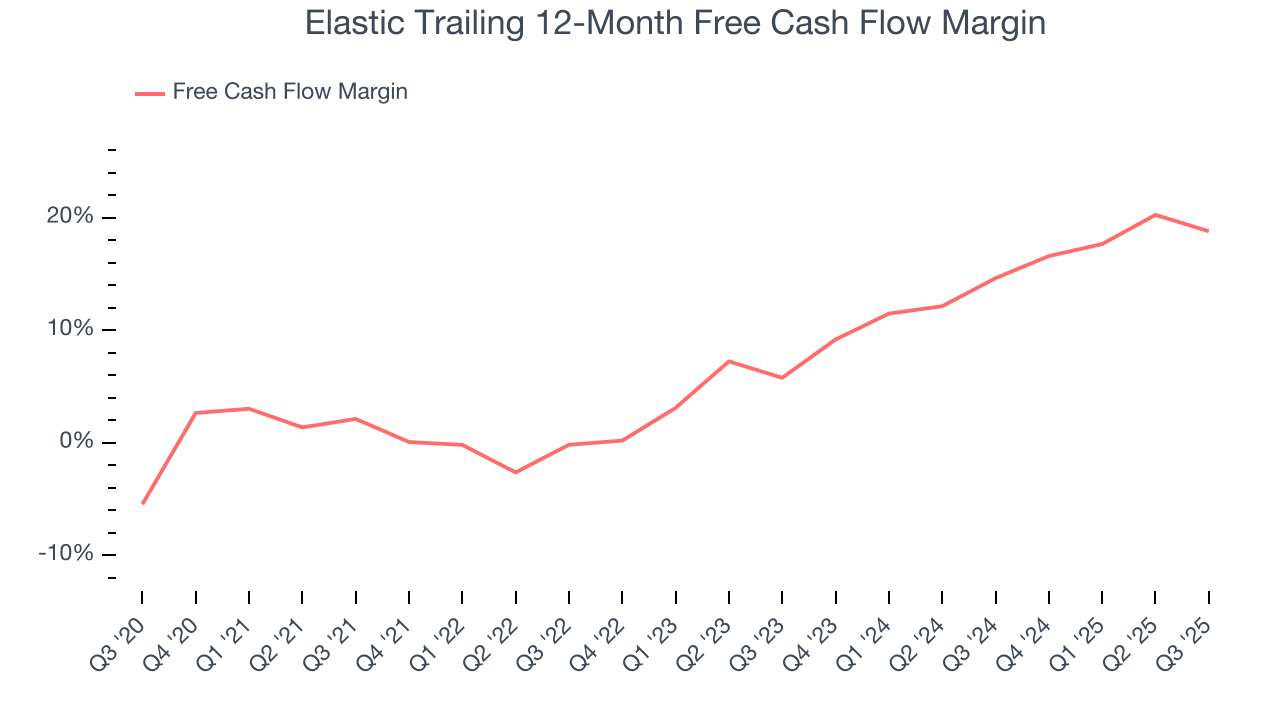
Elastic’s free cash flow clocked in at $26.01 million in Q3, equivalent to a 6.1% margin. The company’s cash profitability regressed as it was 4.2 percentage points lower than in the same quarter last year, prompting us to pay closer attention. Short-term fluctuations typically aren’t a big deal because investment needs can be seasonal, but we’ll be watching to see if the trend extrapolates into future quarters.
Over the next year, analysts’ consensus estimates show they’re expecting Elastic’s free cash flow margin of 18.8% for the last 12 months to remain the same.
13. Balance Sheet Assessment
One of the best ways to mitigate bankruptcy risk is to hold more cash than debt.
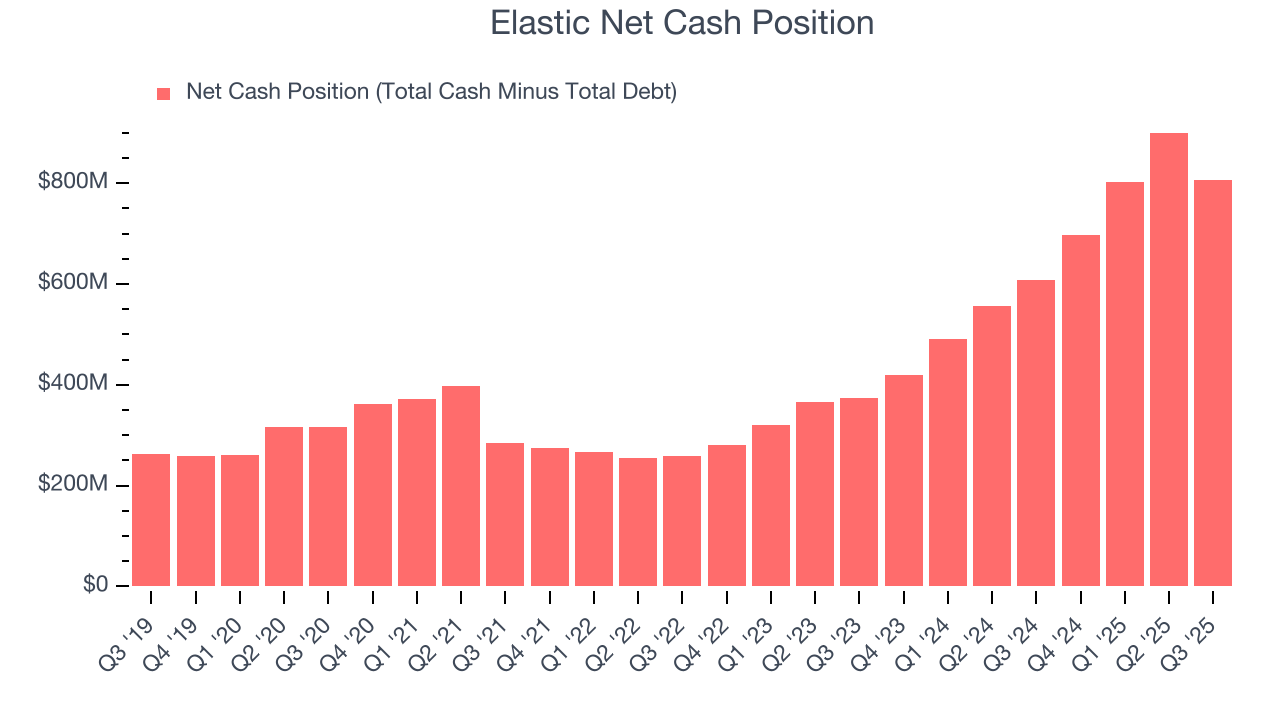
Elastic is a well-capitalized company with $1.40 billion of cash and $590.7 million of debt on its balance sheet. This $805.4 million net cash position is 10.9% of its market cap and gives it the freedom to borrow money, return capital to shareholders, or invest in growth initiatives. Leverage is not an issue here.
14. Key Takeaways from Elastic’s Q3 Results
We were impressed by Elastic’s optimistic EPS guidance for next quarter, which blew past analysts’ expectations. We were also glad its full-year EPS guidance trumped Wall Street’s estimates. On the other hand, its billings missed. Overall, this print had some key positives. Investors were likely hoping for more, and shares traded down 8.3% to $75.24 immediately after reporting.
15. Is Now The Time To Buy Elastic?
Updated: December 24, 2025 at 9:12 PM EST
The latest quarterly earnings matters, sure, but we actually think longer-term fundamentals and valuation matter more. Investors should consider all these pieces before deciding whether or not to invest in Elastic.
Elastic isn’t a terrible business, but it doesn’t pass our quality test. Although its revenue growth was strong over the last five years, it’s expected to deteriorate over the next 12 months and its expanding operating margin shows it’s becoming more efficient at building and selling its software. And while the company’s gross margin suggests it can generate sustainable profits, the downside is its operating margins are low compared to other software companies.
Elastic’s price-to-sales ratio based on the next 12 months is 4.5x. While this valuation is reasonable, we don’t really see a big opportunity at the moment. We're pretty confident there are more exciting stocks to buy at the moment.
Wall Street analysts have a consensus one-year price target of $104.35 on the company (compared to the current share price of $76.63).
Although the price target is bullish, readers should exercise caution because analysts tend to be overly optimistic. The firms they work for, often big banks, have relationships with companies that extend into fundraising, M&A advisory, and other rewarding business lines. As a result, they typically hesitate to say bad things for fear they will lose out. We at StockStory do not suffer from such conflicts of interest, so we’ll always tell it like it is.




